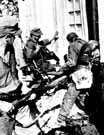
|
|
|

|

|

|

|
|
Click on an image to see a larger, more detailed picture.
|
|
|
|
|
| 1942: The "Final Solution" |

|
pg. 328 |

|
|
|
|
| |
 German troops force their way into a house during the invasion of the Soviet Union. The war against the Bolshevik foe did not differentiate between civilians and soldiers. As the German armies rapidly advanced east, toward Moscow, untold numbers of homes were destroyed and thousands upon thousands of civilians were killed.
German troops force their way into a house during the invasion of the Soviet Union. The war against the Bolshevik foe did not differentiate between civilians and soldiers. As the German armies rapidly advanced east, toward Moscow, untold numbers of homes were destroyed and thousands upon thousands of civilians were killed.
Photo: Central State Archive of Film, Photo, and Phonographic Documents / United States Holocaust Memorial Museum Photo Archive
|
 A Jewish policeman from the Warsaw Ghetto removes a dead baby. Note the emaciated condition of the corpse. Jews lived in the ghetto on starvation rations, and the sick, young, and infirm were the first victims of famine and disease. Infants, many of whom were born dead, were particularly susceptible to these conditions.
A Jewish policeman from the Warsaw Ghetto removes a dead baby. Note the emaciated condition of the corpse. Jews lived in the ghetto on starvation rations, and the sick, young, and infirm were the first victims of famine and disease. Infants, many of whom were born dead, were particularly susceptible to these conditions.
Photo: SYddeutscher Verlag Bilderdienst
|
|
What Was Known in the West In late May 1942, the London-based Polish government-in-exile got news from the Warsaw Jewish Bund. The communication emphasized several points: the Germans had murdered 700,000 Polish Jews; it identified the sites of the death camps and contained a list of the places in which Aktionen were carried out; and the Nazis planned to destroy all of Polish Jewry. On June 2 the British Broadcasting Corporation (BBC) reported the murder figure. The Bund's calculation, however, was too low. As the BBC aired the news that day, Poland's Jewish death toll actually approached two million. A second BBC broadcast on June 26 gave more details about the Bund report. Three days later a World Jewish Congress press conference in London provided corroborating testimony. Public reports in June 1942 about the destruction of Polish Jewry became what scholar Deborah Lipstadt calls "a watershed in the dissemination of information regarding the Final Solution." During the summer of 1942, U.S. President Franklin Roosevelt and British Prime Minister Winston Churchill vowed to hold the Nazis responsible for anti-Jewish atrocities. Meanwhile, downplaying special efforts to rescue Europe's Jews, the Allies' wartime policy contended that winning the war was the best, if not the only, way to save them. This attitude continued until the end of the war, despite late-1942 visits to Churchill and FDR by Jan Karski, a Polish gentile who had witnessed the horrors of the Warsaw Ghetto.
|
|

|

|

|

|
 June 6, 1942: The Jewish ghetto at Kraków, Poland, is liquidated; 6000 Jews from the city are murdered at Belzec.
June 6, 1942: The Jewish ghetto at Kraków, Poland, is liquidated; 6000 Jews from the city are murdered at Belzec.
|
 June 7, 1942: A Jewish woman who has escaped from the Warsaw Ghetto into the city proper is dragged back to the ghetto and shot.
June 7, 1942: A Jewish woman who has escaped from the Warsaw Ghetto into the city proper is dragged back to the ghetto and shot.
|
 June 7, 1942: The Jewish Yellow Star is made mandatory in Occupied France.
June 7, 1942: The Jewish Yellow Star is made mandatory in Occupied France.
|
 June 8, 1942: The Jewish Council at Pilica, Poland, warns that every able-bodied Jew must attempt to flee to nearby forests.
June 8, 1942: The Jewish Council at Pilica, Poland, warns that every able-bodied Jew must attempt to flee to nearby forests.
|
|
|
|
|
| 1942: The "Final Solution" |

|
pg. 328 |

|
|
The Holocaust Chronicle
© 2009 Publications International, Ltd.
|
|
